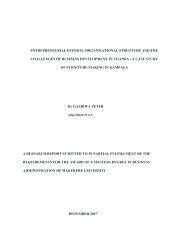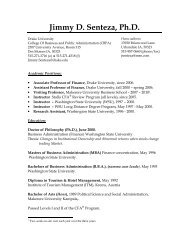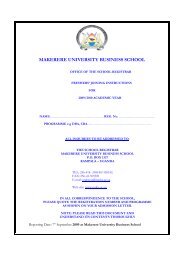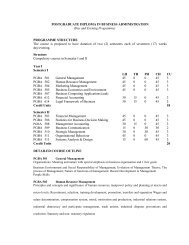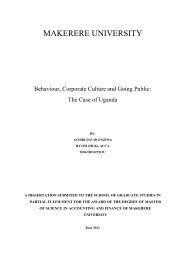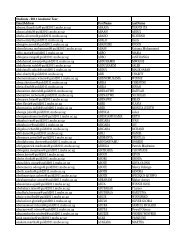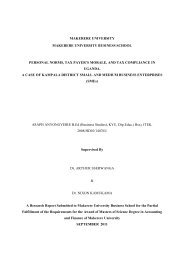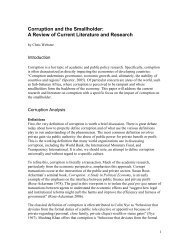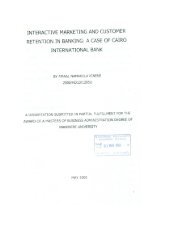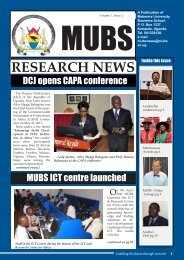13th Annual International Management Conference Proceeding
13th Annual International Management Conference Proceeding
13th Annual International Management Conference Proceeding
Create successful ePaper yourself
Turn your PDF publications into a flip-book with our unique Google optimized e-Paper software.
DETERMINANTS OF AGRICULTURAL OUTPUT IN A RURAL SETTING<br />
A CASE OF BANANA PRODUCTION IN NTUNGAMO DISTRICT<br />
By<br />
Mr. Turyahikayo Willy<br />
Lecturer, Makerere University Business School<br />
Finance Dept.<br />
P.O.Box 1337 Kampala<br />
E-mail: wturyahikayo@yahoo.com<br />
Tel: +256-772-957295<br />
Abstract<br />
The study on determinants of agricultural output was done in Nyakyera Sub-County in Ntungamo District. The study<br />
used Banana production as a case study. The study had the following objectives;<br />
i)To estimate the effect of Land, Labour and Capital on banana production in Nyakyera Sub County.<br />
ii) To find out the effect of Social, Economic and Environmental factors on banana production in Nyakyera Sub County<br />
To achieve the above, 200 respondents were chosen using a systematic random sampling technique from four parishes.<br />
A Poison regression analysis was conducted to estimate a Cobb-Douglas Production function. It was found that Land,<br />
Labour, Capital and Manure application are all significant determinants of Banana production in the area. A qualitative<br />
technique was used to explore other factors which influence banana production. From this qualitative analysis, it was<br />
found that culture, government policy, cultural division of labour, land tenure systems and land ownership systems<br />
influence banana production negatively. The study also offered policy prescriptions for improving agricultural<br />
production. Among these were the need for massive sensitisation to break the cultural beliefs on the use of improved<br />
varieties which have for a long time impeded agricultural output and gender division of labour. The study ended by<br />
suggesting other areas for future research.<br />
1.0 INTRODUCTION<br />
In a continent in which the urban employed population is tiny, in which only a small proportion of the<br />
population derives their living directly from non- agricultural source, the development of agriculture is<br />
almost synonymous with economic development. Until intermediate demand has grown to a level sufficient<br />
to support a nascent capital goods industry, the bulk of the population must rely upon increasing agricultural<br />
output for an improvement in the standard of living. According to Nypan and Astrid, the connection<br />
between economic development and agriculture was noted as early as 1914 to be as close as to be identical.<br />
Agriculture is an important branch of the whole economy in most less developed countries. More than 70%<br />
of the labour force in sub Saharan Africa finds its livelihood in agriculture. However, Africa has performed<br />
poorly in agriculture and specifically in food production with more than half of Africa living on food<br />
emergencies. More than half of sub-Saharan African countries are said to live on food emergencies. Africa as<br />
a whole was noted to have been experiencing a drop in per capita food out put. As early as 1981, Uganda<br />
was noted to be amongst those countries faced with per capita food output problem. The per capita food<br />
out put had fallen by more than 30% within that period. (Glantz 1987).<br />
In Uganda, the importance of agriculture can be gauged from the percentage of the population engaged in<br />
agriculture compared to the total population, from the size of agricultural GDP in relation to the total GDP<br />
or else from the place held by the agricultural produce in total exports.<br />
Judging by the three criteria considered, Uganda is amongst most agricultural countries in the sub- Saharan.<br />
The corollary is that GDP per person engaged in agriculture is lower than the per capita GDP. This lower<br />
GDP per “agricultural worker” suggests that the productivity of agricultural labour is low and that the level<br />
of agricultural income is likewise very low.<br />
When the NRM government came to power in 1986, there was a need to reverse the trend of major macro<br />
economic variables so as to regain a stable and more sustainable macro economic structure. An economic<br />
recovery programme (ERP) was introduced in 1987.<br />
70



